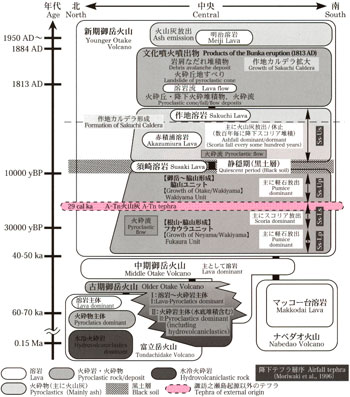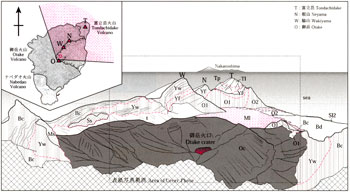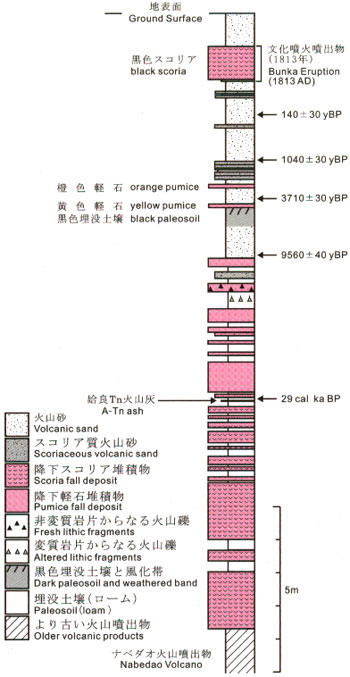3: Geological history
3.1 Overview
The geological history of Suwanosejima Volcano is shown in ![]() Fig. 3. Though the onset age of the volcanic activity is unknown, Tondachidake and Nabedao volcanoes seem to have grown into subaerial volcanoes by 50-60 ka, judging from the results of K-Ar dating of lava distributed around their shoreline. Otake Volcano has grown through the activity around the present Otake crater and now covers both Tondachidake and Nabedao volcanoes. Otake Volcano seems to have become a volcanic edifice 400-500 m high by 40-50 ka, judging from the ages of the underlying and overlying deposits at some localities in Suwanosejima. Large explosive activities with pumice and scoria fall deposits seen in the distal part of the island have continued from 40-50 ka until 10 ka. Then, such explosive eruptions decreased, and successive ash-emitting activities with some repose intervals became dominant until recently.
Fig. 3. Though the onset age of the volcanic activity is unknown, Tondachidake and Nabedao volcanoes seem to have grown into subaerial volcanoes by 50-60 ka, judging from the results of K-Ar dating of lava distributed around their shoreline. Otake Volcano has grown through the activity around the present Otake crater and now covers both Tondachidake and Nabedao volcanoes. Otake Volcano seems to have become a volcanic edifice 400-500 m high by 40-50 ka, judging from the ages of the underlying and overlying deposits at some localities in Suwanosejima. Large explosive activities with pumice and scoria fall deposits seen in the distal part of the island have continued from 40-50 ka until 10 ka. Then, such explosive eruptions decreased, and successive ash-emitting activities with some repose intervals became dominant until recently.
3.2 Tondachidake and Nabedao volcanoes
Tondachidake and Nabedao volcanoes are the lowermost units in the subaerial part of Suwanosejima Volcano.
Tondachidake Volcano is located in the northern part of the island. Its base consists of alternating layers of deposits by phreatomagmatic eruptions that have cauliflower-shaped volcanic bombs with a quenched rim. We call the deposit “hydrovolcanic rocks.” The overlying deposit consists of alternating layers of subaerial lava and pyroclastic deposits that form a small composite volcanic edifice. There are several sheets of dikes that show a radial distribution from the summit of Tondachidake. K-Ar dating of the lava in the middle part of Tondachidake Volcano indicates an age of 65±15 ka (Matsumoto et al., 2006). Tondachidake Volcano could be the oldest volcano, judging from its topographic features with more heavily distributed gullies than the other edifices.
Nabedao Volcano is located in the southern part of the island and consists of a stratified main edifice and Makkodai Lava at the southernmost portion. The results of K-Ar dating of lava at the basal part of the main edifice and of some lobes of Makkodai Lava indicate an age of ca. 150 ka and ca. 60-70 ka, respectively (Toshida et al., 2004). A drilling survey by Japan Meteorological Agency (JMA) in 2009 showed that the apparent thickness of andesite lava near the summit of Nabedao was ca. 100 m (Group for Drilling Core Analysis, Coordinating Committee for the Prediction of Volcanic Eruption, 2011), whereas a drilling survey near Makkodai showed a lava thickness >80 m (Oshima, 2000). Although Nabedao Volcano is heavily eroded, it could be younger than Tondachidake Volcano, considering that the surface topography of the crater and lava flows has still partly survived erosion.
3.3 Otake Volcano
Otake Volcano is in the central part of the island and forms a stratified volcanic edifice mostly with andesitic lavas and agglutinates. The volcano has been subdivided into three volcanoes according to major unconformities; these are Older, Middle, and Younger Otake volcanoes, in ascending order (e.g., Hirasawa and Matsumoto, 1983). Here we define the following new classification of Older, Middle, and Younger Otake volcanoes based on recent findings and previous reports.
3.3.1 Products of Older Otake Volcano
The deposits at Older Otake Volcano occur at the bottom of Sakuchi Caldera. The deposit can be subdivided into Older Otake deposits I and II, in descending order, based on an unconformity and lithology. Older Otake I consists of altered lava and pyroclastics, and Older Otake II consists of pyroclastics with finely stratified structures indicating deposition under water.
The distribution of the edifice of Older Otake Volcano is unknown because it is mostly covered by Middle and Younger Otake volcanoes. However, the eruptive center seems to have moved westward gradually, judging from the westerly incline and distribution of its upper layers.
3.3.2 Products of Middle Otake Volcano
The deposits at Middle Otake Volcano occur on the northwestern shore from around the south of Fukaura to Susaki, and on the southeastern shore from the south of Sakuchibana to Iwatsumiishi. We subdivided this volcano into northern and southern units, respectively, though the stratigraphic relation between these units is unidentified. However, the distribution of the lavas indicates that the eruptive center was located near the summit of Otake for both units. The Middle Otake volcanic deposit consists mainly of subaerial lava flows with minor pyroclastics. The edifice of Middle Otake Volcano is highly eroded, but some lobes of lava flows remain uneroded. K-Ar dating of lava from Middle Otake Volcano at Iwatsumiishi indicates an age of 67±7 ka (Toshida et al., 2004).
3.3.3 Products of Younger Otake Volcano
The deposits of Younger Otake Volcano are the volcanic products from 40-50 ka to present. The deposits of Younger Otake Volcano can be mainly classified into thick agglutinates and pyroclastic flow deposits in the proximal part, and pyroclastic fall deposits and some lava flows at the foot of Mt. Otake.
The thick agglutinates at Younger Otake Volcano occur near the summits of Wakiyama and Otake and cover the Older and Middle Otake volcanic deposits. The total thickness of the agglutinates reaches a maximum of 150 m. The agglutinates can be subdivided into three units based on the degree of welding or the unconformity. The lowest unit of alternating agglutinates, Fukaura Unit, occurs around the summit of Mt. Neyama to the north of Mt. Otake. The agglutinate layers of the upper unit, Wakiyama Unit, occur around Otake crater. The uppermost agglutinate layers are those of the 1813 eruption and occur in the area around Otake and Kyukako craters.
The thick pyroclastic fall deposits of Younger Otake Volcano widely cover the foot of Mt. Otake (![]() Fig. 5). The lower half consists of scoria and pumice fall deposits with a maximum total thickness of ca. 20 m (Moriwaki et al., 1996). These deposits could be correlated with the agglutinates in the proximal area, judging from the characteristic facies and alternating patterns of the layers. A key tephra layer, A-Tn, is found in this scoria-pumice deposit, indicating an age of 29 cal ka BP (Moriwaki et al., 1996). A 14C age of charcoal around 30 ka was obtained from around the base of the Younger Otake volcanic deposit at Fukaura Bay in the northern part of the island (Fukaura Unit; Matsumoto et al., 2006). Thus, it is inferred that Younger Otake Volcano started its activity at around 40-50 ka.
Fig. 5). The lower half consists of scoria and pumice fall deposits with a maximum total thickness of ca. 20 m (Moriwaki et al., 1996). These deposits could be correlated with the agglutinates in the proximal area, judging from the characteristic facies and alternating patterns of the layers. A key tephra layer, A-Tn, is found in this scoria-pumice deposit, indicating an age of 29 cal ka BP (Moriwaki et al., 1996). A 14C age of charcoal around 30 ka was obtained from around the base of the Younger Otake volcanic deposit at Fukaura Bay in the northern part of the island (Fukaura Unit; Matsumoto et al., 2006). Thus, it is inferred that Younger Otake Volcano started its activity at around 40-50 ka.
Volcanic sand layers of several meters in thickness cover the scoria and pumice layers in the village area in the southern part of the island (![]() Fig. 5). A 14C dating of charcoal around 10 ka are obtained from a black soil between the pumice fall layer and the volcanic sand layer near Motoura Port, indicating that the dominant activity shifted from relatively large explosive eruptions into moderate but successive ash emissions at ca. 10 ka.
Fig. 5). A 14C dating of charcoal around 10 ka are obtained from a black soil between the pumice fall layer and the volcanic sand layer near Motoura Port, indicating that the dominant activity shifted from relatively large explosive eruptions into moderate but successive ash emissions at ca. 10 ka.
There are some remarkable lava flows on Younger Otake Volcano. Susaki Lava is pyroxene-bearing, thick dacite lava and occurs on the western shore of the island. There are no dating results on the age of this lava, but judging from the stratigraphic relation, the lava could have erupted during the active stage of Younger Otake Volcano. There are at least three lobes of lava flows on the eastern coast of the island in Sakuchi Caldera. All are pyroxene-bearing andesite lava and, judging from their distribution, are considered to have erupted from Otake crater. A lobe of andesite lava, called Akazumiura Lava, occurs on the western coast of the island, which is covered by pyroclastic deposits of the 1813 eruption.


